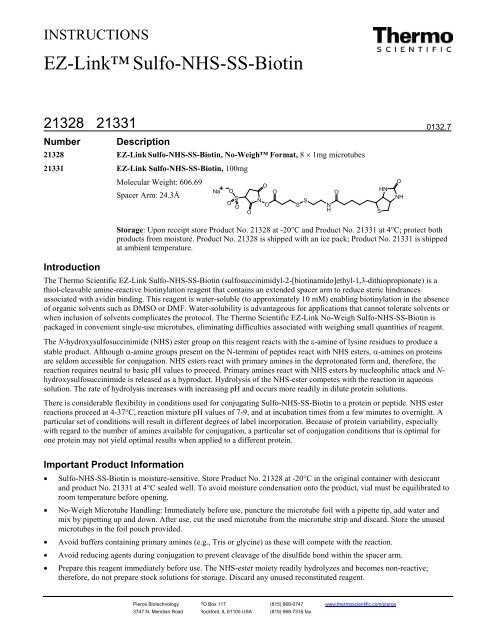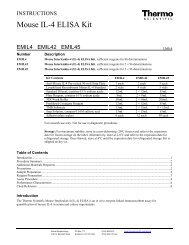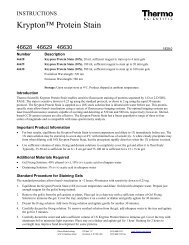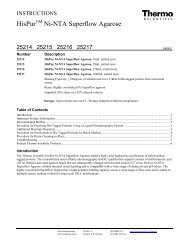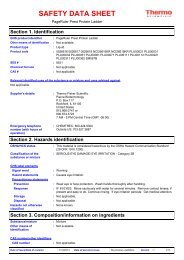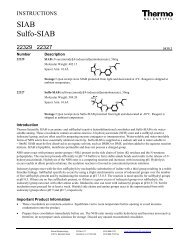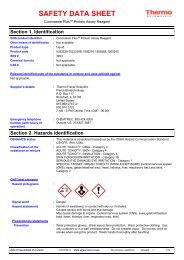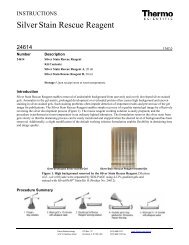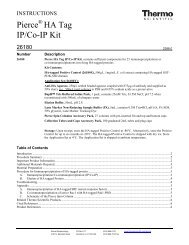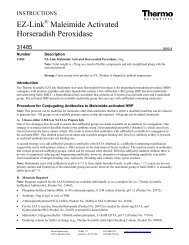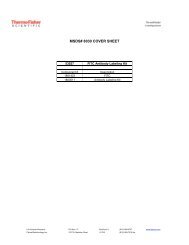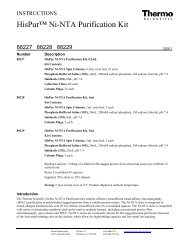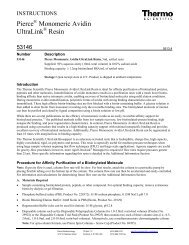EZ-Link™Sulfo-NHS-SS-Biotin - Pierce
EZ-Link™Sulfo-NHS-SS-Biotin - Pierce
EZ-Link™Sulfo-NHS-SS-Biotin - Pierce
Create successful ePaper yourself
Turn your PDF publications into a flip-book with our unique Google optimized e-Paper software.
INSTRUCTIONS<br />
<strong>EZ</strong>-Link Sulfo-<strong>NHS</strong>-<strong>SS</strong>-<strong>Biotin</strong><br />
21328 21331<br />
Number Description<br />
21328 <strong>EZ</strong>-Link Sulfo-<strong>NHS</strong>-<strong>SS</strong>-<strong>Biotin</strong>, No-Weigh Format, 8 × 1mg microtubes<br />
21331 <strong>EZ</strong>-Link Sulfo-<strong>NHS</strong>-<strong>SS</strong>-<strong>Biotin</strong>, 100mg<br />
Molecular Weight: 606.69<br />
O<br />
Spacer Arm: 24.3Å<br />
Na<br />
O<br />
O<br />
Introduction<br />
O<br />
S<br />
O<br />
O<br />
O<br />
N<br />
O<br />
Storage: Upon receipt store Product No. 21328 at -20°C and Product No. 21331 at 4°C; protect both<br />
products from moisture. Product No. 21328 is shipped with an ice pack; Product No. 21331 is shipped<br />
at ambient temperature.<br />
The Thermo Scientific <strong>EZ</strong>-Link Sulfo-<strong>NHS</strong>-<strong>SS</strong>-<strong>Biotin</strong> (sulfosuccinimidyl-2-[biotinamido]ethyl-1,3-dithiopropionate) is a<br />
thiol-cleavable amine-reactive biotinylation reagent that contains an extended spacer arm to reduce steric hindrances<br />
associated with avidin binding. This reagent is water-soluble (to approximately 10 mM) enabling biotinylation in the absence<br />
of organic solvents such as DMSO or DMF. Water-solubility is advantageous for applications that cannot tolerate solvents or<br />
when inclusion of solvents complicates the protocol. The Thermo Scientific <strong>EZ</strong>-Link No-Weigh Sulfo-<strong>NHS</strong>-<strong>SS</strong>-<strong>Biotin</strong> is<br />
packaged in convenient single-use microtubes, eliminating difficulties associated with weighing small quantities of reagent.<br />
The N-hydroxysulfosuccinimide (<strong>NHS</strong>) ester group on this reagent reacts with the ε-amine of lysine residues to produce a<br />
stable product. Although α-amine groups present on the N-termini of peptides react with <strong>NHS</strong> esters, α-amines on proteins<br />
are seldom accessible for conjugation. <strong>NHS</strong> esters react with primary amines in the deprotonated form and, therefore, the<br />
reaction requires neutral to basic pH values to proceed. Primary amines react with <strong>NHS</strong> esters by nucleophilic attack and Nhydroxysulfosuccinimide<br />
is released as a byproduct. Hydrolysis of the <strong>NHS</strong>-ester competes with the reaction in aqueous<br />
solution. The rate of hydrolysis increases with increasing pH and occurs more readily in dilute protein solutions.<br />
There is considerable flexibility in conditions used for conjugating Sulfo-<strong>NHS</strong>-<strong>SS</strong>-<strong>Biotin</strong> to a protein or peptide. <strong>NHS</strong> ester<br />
reactions proceed at 4-37°C, reaction mixture pH values of 7-9, and at incubation times from a few minutes to overnight. A<br />
particular set of conditions will result in different degrees of label incorporation. Because of protein variability, especially<br />
with regard to the number of amines available for conjugation, a particular set of conjugation conditions that is optimal for<br />
one protein may not yield optimal results when applied to a different protein.<br />
Important Product Information<br />
• Sulfo-<strong>NHS</strong>-<strong>SS</strong>-<strong>Biotin</strong> is moisture-sensitive. Store Product No. 21328 at -20°C in the original container with desiccant<br />
and product No. 21331 at 4°C sealed well. To avoid moisture condensation onto the product, vial must be equilibrated to<br />
room temperature before opening.<br />
• No-Weigh Microtube Handling: Immediately before use, puncture the microtube foil with a pipette tip, add water and<br />
mix by pipetting up and down. After use, cut the used microtube from the microtube strip and discard. Store the unused<br />
microtubes in the foil pouch provided.<br />
• Avoid buffers containing primary amines (e.g., Tris or glycine) as these will compete with the reaction.<br />
• Avoid reducing agents during conjugation to prevent cleavage of the disulfide bond within the spacer arm.<br />
• Prepare this reagent immediately before use. The <strong>NHS</strong>-ester moiety readily hydrolyzes and becomes non-reactive;<br />
therefore, do not prepare stock solutions for storage. Discard any unused reconstituted reagent.<br />
<strong>Pierce</strong> Biotechnology PO Box 117 (815) 968-0747 www.thermoscientific.com/pierce<br />
3747 N. Meridian Road Rockford, lL 61105 USA (815) 968-7316 fax<br />
S S<br />
N<br />
H<br />
HN<br />
S<br />
O<br />
NH<br />
0132.7
Example Procedure for <strong>Biotin</strong>ylating IgG with Sulfo-<strong>NHS</strong>-<strong>SS</strong>-<strong>Biotin</strong><br />
The following protocol is an example application. Specific applications require optimization.<br />
A. Additional Materials Required<br />
• Reaction Buffer: Phosphate-buffered saline (e.g., 0.1M phosphate, 0.15M sodium chloride; pH 7.2; Product No. 28372),<br />
or other non-amine containing buffer at pH 7.0-8.5<br />
• Method for removing non-reacted biotin (buffer exchange): Thermo Scientific Slide-A-Lyzer MINI Dialysis Units for<br />
10-100µL samples (Product No. 69576); Slide-A-Lyzer ® Dialysis Cassette Kit for 0.5-3.0mL samples (Product No.<br />
66382); or Dextran Desalting Columns, 5K MWCO, for samples up to 1.25mL (Product No. 43230)<br />
• Reducing Agent: DTT (Product No. 20290) or 2-mercaptoethanol (Product No. 35602) for cleaving the disulfide bond<br />
B. Calculations<br />
The amount of biotin reagent to use for each reaction depends on the amount of the protein to be labeled and the protein<br />
concentration. By using the appropriate molar ratio of biotin to the protein, the extent of labeling can be controlled. When<br />
labeling dilute protein solutions (e.g., 2mg/mL) a greater molar fold excess of biotin is used compared to a concentrated<br />
protein solution (e.g., 10mg/mL). For example, for best results use ≥ 12-fold molar excess of biotin for a 10mg/mL IgG<br />
solution or ≥ 20-fold molar excess of biotin for a mg/mL IgG solution.<br />
1. Calculate millimoles of Sulfo-<strong>NHS</strong>-<strong>SS</strong>-<strong>Biotin</strong> to add to the reaction for a 20-fold molar excess:<br />
mg protein mmol protein 20 mmol <strong>Biotin</strong><br />
ml protein ×<br />
×<br />
×<br />
= mmol <strong>Biotin</strong><br />
ml protein mg protein mmol protein<br />
2. Calculate microliters of 10mM Sulfo-<strong>NHS</strong>-<strong>SS</strong>-<strong>Biotin</strong> (prepared in Step C.2) to add to the reaction:<br />
607 mg 1000 μl<br />
mmol <strong>Biotin</strong> ×<br />
× = μl <strong>Biotin</strong><br />
mmol <strong>Biotin</strong> 6.0 mg<br />
• 20 = Recommended molar fold excess of biotin for 2mg/mL IgG sample<br />
• 607 = Molecular weight of Sulfo-<strong>NHS</strong>-<strong>SS</strong>-<strong>Biotin</strong><br />
• 1000 = Microliters of water in which 6.0mg of Sulfo-<strong>NHS</strong>-<strong>SS</strong>-<strong>Biotin</strong> is dissolved for a 10mM solution<br />
Example: For 1mL of IgG (150,000 MW) at 2mg/mL, 26.9µL of 10mM Sulfo-<strong>NHS</strong>-<strong>SS</strong>-<strong>Biotin</strong> will be added.<br />
2 mg IgG 1mmol<br />
IgG 20 mmol <strong>Biotin</strong><br />
1 ml IgG × ×<br />
×<br />
= 0.000266 mmol <strong>Biotin</strong><br />
1ml<br />
IgG 150,000 mg IgG 1mmol<br />
IgG<br />
607 mg 1000 μl<br />
0.000266 mmol <strong>Biotin</strong> ×<br />
× = 26.9 μl Sulfo - <strong>NHS</strong> - <strong>SS</strong> - <strong>Biotin</strong><br />
mmol <strong>Biotin</strong> 6.0 mg<br />
C. <strong>Biotin</strong>ylation<br />
For reaction volumes from 10-100µL, the buffer exchange and biotinylation may be conveniently performed in a single<br />
Slide-A-Lyzer MINI Dialysis Unit. For reaction volumes from 0.1-12mL, Slide-A-Lyzer Dialysis Cassettes may be used.<br />
1. Dissolve or buffer exchange IgG into Reaction Buffer.<br />
2. Immediately before use, prepare a 10mM solution of Sulfo-<strong>NHS</strong>-<strong>SS</strong>-<strong>Biotin</strong> as follows:<br />
• <strong>EZ</strong>-Link Sulfo-<strong>NHS</strong>-<strong>SS</strong>-<strong>Biotin</strong>: Add 1mL of ultrapure water to 6mg of reagent.<br />
• No-Weigh Sulfo-<strong>NHS</strong>-<strong>SS</strong>-<strong>Biotin</strong>: Add 164µL of ultrapure water to the 1mg microtube.<br />
3. Add the appropriate volume of the Sulfo-<strong>NHS</strong>-<strong>SS</strong>-<strong>Biotin</strong> solution (see Calculations section) to the IgG solution.<br />
4. Incubate reaction on ice for two hours or at room temperature for 30 minutes.<br />
<strong>Pierce</strong> Biotechnology PO Box 117 (815) 968-0747 www.thermoscientific.com/pierce<br />
3747 N. Meridian Road Rockford, lL 61105 USA (815) 968-7316 fax<br />
2
5. Remove the non-reacted Sulfo-<strong>NHS</strong>-<strong>SS</strong>-<strong>Biotin</strong> by dialysis or gel filtration. See instructions provided with preferred<br />
buffer exchange product.<br />
6. Store the biotinylated protein using the same condition that is optimal for the non-biotinylated protein.<br />
7. To cleave the disulfide bond in the spacer arm, incubate sample in 50mM DTT for 2 hours at room temperature or for 30<br />
minutes at 50°C. Other reducing agents may also be used to cleave the disulfide bond.<br />
Example Procedure for <strong>Biotin</strong>ylating Cell Surface Proteins<br />
The following protocol is an example application. Specific applications require optimization.<br />
1. Wash cells three times with ice-cold PBS (pH 8.0) to remove any contaminating proteins.<br />
2. Suspend cells at a concentration of 25 × 10 6 cells/mL in PBS (pH 8.0).<br />
Note: Other cell concentrations may be used. Scale the concentration of biotinylation reagent up or down based on cell<br />
concentration, size or type.<br />
3. Immediately before use, prepare a 10mM solution of Sulfo-<strong>NHS</strong>-<strong>SS</strong>-<strong>Biotin</strong> by adding 6mg to 1mL of ultrapure water.<br />
4. Add ~80µL of 10mM Sulfo-<strong>NHS</strong>-<strong>SS</strong>-<strong>Biotin</strong> per milliliter of reaction volume.<br />
5. Incubate reacting at room temperature for 30 minutes.<br />
6. Wash cells three times with ice-cold PBS (pH 8.0) to remove non-reacted biotinylation reagent. Alternatively, 25-50mM<br />
Tris (pH 8.0) may be used for the initial wash to quench any non-reacted biotinylation reagent.<br />
Troubleshooting<br />
Problem Cause Solution<br />
Lack of biotinylation No amines available on<br />
molecule of interest<br />
<strong>Pierce</strong> Biotechnology PO Box 117 (815) 968-0747 www.thermoscientific.com/pierce<br />
3747 N. Meridian Road Rockford, lL 61105 USA (815) 968-7316 fax<br />
3<br />
Use a biotinylation reagent that targets a different functional<br />
group or convert sulfhydryl to amine using Thermo Scientific<br />
Aminoethyl-8 (Product No. 23010)<br />
Buffer contains primary amines Use a non-amine containing buffer<br />
Reagent not reactive caused by Allow reagent vial to equilibrate to room temperature before<br />
Hydrolysis of the <strong>NHS</strong> ester opening and use reagent immediately upon reconstitution<br />
Incomplete removal of primary<br />
amines<br />
Dialyze or desalt into a buffer free of primary amines<br />
Protein lost function Excessive biotinylation Reduce molar excess of biotinylation reagent, or reduce time<br />
or temperature for biotinylation<br />
Choose biotinylation reagent that targets different groups<br />
Additional Information<br />
Determination of <strong>Biotin</strong> Incorporation<br />
<strong>Biotin</strong> incorporation can be estimated using HABA [2-(4´-hydroxyazobenzene)-2-carboxylic acid]. This method is based on<br />
the ability of the HABA dye to bind avidin forming a complex with maximal absorption at 500nm. <strong>Biotin</strong> is then added to the<br />
solution and because of its higher affinity for avidin, biotin displaces the HABA and the absorption at 500nm decreases<br />
proportionately. The absorbance of the HABA-avidin solution is measured before and after adding the biotin-containing<br />
sample. The change in absorbance relates to the amount of biotin in the sample. (See Related Products section.)
Related Thermo Scientific Products<br />
28005 <strong>Pierce</strong> <strong>Biotin</strong> Quantitation Kit, contains HABA and a biotinylated standard<br />
33033 Sulfo-SBED <strong>Biotin</strong> Label Transfer Reagent, 10mg, for protein:protein interaction studies<br />
20228 <strong>Pierce</strong> Monomeric Avidin Agarose, reversible biotin-binding resin<br />
20227 <strong>Pierce</strong> Monomeric Avidin Kit, complete kit for purifying biotinylated molecules<br />
20347 Streptavidin Agarose Resin, 2mL<br />
Alternative <strong>EZ</strong>-Link <strong>Biotin</strong>ylation Products:<br />
21445 Sulfo-<strong>NHS</strong>-<strong>SS</strong>-<strong>Biotin</strong>ylation Kit, ~10 reactions with 1-10mg of protein<br />
21945 Micro Sulfo-<strong>NHS</strong>-<strong>SS</strong>-<strong>Biotin</strong>ylation Kit, 8 reactions with 50-200µg of protein<br />
21925 Micro Sulfo-<strong>NHS</strong>-<strong>Biotin</strong>ylation Kit, 8 reactions with 50-200µg of protein<br />
21935 Micro Sulfo-<strong>NHS</strong>-LC-<strong>Biotin</strong>ylation Kit, 8 reactions with 50-200µg of protein<br />
21327 Sulfo-<strong>NHS</strong>-LC-<strong>Biotin</strong>, No-Weigh Format, 8 × 1mg microtubes<br />
21326 Sulfo-<strong>NHS</strong>-<strong>Biotin</strong>, No-Weigh Format, 8 × 1mg microtubes<br />
21329 <strong>NHS</strong>-PEG4-<strong>Biotin</strong>, No-Weigh Format, 8 × 2mg microtubes<br />
General References<br />
Altin, J.G., et al. (1995). A One-Step Procedure for <strong>Biotin</strong>ylation and Chemical Cross-linking of Lymphocyte Surface and Intracellular Membrane-<br />
Associated Molecules. Anal Biochem224:382-9.<br />
Chaiet, I. and Wolf, F.J. (1964). The properties of streptavidin, a biotin-binding protein produced by Streptomycetes. Arch Biochem Biophys 106:1-5.<br />
Hnatowich, D.J., et al. (1987). Investigations of avidin and biotin for imaging applications. J Nucl Med 28:1294-1302.<br />
Hofmann, K., et al. (1980). Iminobiotin affinity columns and their application to retrieval of streptavidin. Proc Natl Acad Sci 77(8):4666-8.<br />
Gitlin, G., et al. (1987). Studies of the biotin-binding site of avidin. Biochem J 242:923-6.<br />
Green, N.M., et al. (1971). The use of bifunctional biotinyl compounds to determine the arrangement of subunits in avidin. Biochem J 125:781-91.<br />
Green, N.M. (1965). A spectrophotometric assay for avidin and biotin based on binding dyes by avidin. Biochem J 94:23c-24c.<br />
Green, N.M. (1975). Avidin. In Adv. in Protein Chemistry. Academic Press, New York. 29:85-133.<br />
Gretch, D.R., et al. (1987). The use of biotinylated monoclonal antibody and streptavidin affinity chromatography to isolate herpes virus hydrophobic<br />
proteins or glycoproteins. Anal Biochem 163:270-7.<br />
Shimkus, M., et al. (1985). A chemically cleavable biotinylated nucleotide: Usefulness in the recovery of protein-DNA complexes from avidin affinity<br />
columns. Proc Natl Acad Sci 82:2593-7.<br />
This product (“Product”) is warranted to operate or perform substantially in conformance with published Product specifications in effect at the time of sale,<br />
as set forth in the Product documentation, specifications and/or accompanying package inserts (“Documentation”) and to be free from defects in material and<br />
workmanship. Unless otherwise expressly authorized in writing, Products are supplied for research use only. No claim of suitability for use in applications<br />
regulated by FDA is made. The warranty provided herein is valid only when used by properly trained individuals. Unless otherwise stated in the<br />
Documentation, this warranty is limited to one year from date of shipment when the Product is subjected to normal, proper and intended usage. This<br />
warranty does not extend to anyone other than the original purchaser of the Product (“Buyer”).<br />
No other warranties, express or implied, are granted, including without limitation, implied warranties of merchantability, fitness for any particular<br />
purpose, or non infringement. Buyer’s exclusive remedy for non-conforming Products during the warranty period is limited to replacement of or<br />
refund for the non-conforming Product(s).<br />
There is no obligation to replace Products as the result of (i) accident, disaster or event of force majeure, (ii) misuse, fault or negligence of or by Buyer, (iii)<br />
use of the Products in a manner for which they were not designed, or (iv) improper storage and handling of the Products.<br />
Current product instructions are available at www.thermoscientific.com/pierce. For a faxed copy, call 800-874-3723 or contact your local distributor.<br />
© 2012 Thermo Fisher Scientific Inc. All rights reserved. Unless otherwise indicated, all trademarks are property of Thermo Fisher Scientific Inc. and its<br />
subsidiaries. Printed in the USA.<br />
<strong>Pierce</strong> Biotechnology PO Box 117 (815) 968-0747 www.thermoscientific.com/pierce<br />
3747 N. Meridian Road Rockford, lL 61105 USA (815) 968-7316 fax<br />
4


